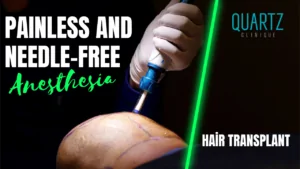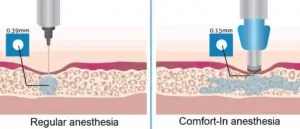 Painless and Needle-Free Hair Transplant: The fear of experiencing pain and soreness while under anesthesia is the main concern for patients during surgical procedures. Hair loss, whether caused by disease, trauma, or genetics, poses a significant challenge for individuals. However, with advancements in technology, a Painless and Needle-Free Hair Transplant offers a viable solution for those seeking effective treatment. The best procedure for thinning hair is hair transplantation, which is highly recommended. Regardless of gender, hair transplantation can be done on both men and women. For those who want to regrow their hair, a painless hair transplant is preferred. People who want to have the procedure may be discouraged by the thought of the pain in their heads. It is important to thoroughly research the procedure processes in order to determine whether the hair transplantation process is painful or not.
Painless and Needle-Free Hair Transplant: The fear of experiencing pain and soreness while under anesthesia is the main concern for patients during surgical procedures. Hair loss, whether caused by disease, trauma, or genetics, poses a significant challenge for individuals. However, with advancements in technology, a Painless and Needle-Free Hair Transplant offers a viable solution for those seeking effective treatment. The best procedure for thinning hair is hair transplantation, which is highly recommended. Regardless of gender, hair transplantation can be done on both men and women. For those who want to regrow their hair, a painless hair transplant is preferred. People who want to have the procedure may be discouraged by the thought of the pain in their heads. It is important to thoroughly research the procedure processes in order to determine whether the hair transplantation process is painful or not.
Most of the patients who are considering FUE hair transplantation have inquiries about pain perception and the number of injections that will be administered. Sapphire hair transplantation is carried out under local anesthesia, which numbs a specific area with drugs injected under the skin.
The patient won’t experience any pain during the hair transplant thanks to this technique. But at this point, patients with needle phobias or pain phobias may start to feel uncomfortable. Local anesthesia is the aspect of the procedure that worries patients the most.
Is It Possible To Get Painless and Needle-Free Hair Transplant?
A hair transplant is typically a pleasant and easy experience for the majority of people who are experiencing hair loss, even though no surgery can be completely painless and some brief and probably temporary level of discomfort is possible. A hair transplant is not painful thanks to local anesthesia and post-operative pain relievers.
This does not, however, imply that there is no discomfort at all. Hair transplants are no different from other minimally invasive or benign medical procedures in that they can cause some discomfort. Fortunately, the “pain” only lasts a short while. Most patients describe a hair transplant as being very simple and even mildly enjoyable, with almost no reported pain.
What’s The Most Painless and Needle-Free Hair Transplant Method?
 Local anesthesia has been used in a variety of ways in recent years to lessen patients’ fear and anxiety, and some of these techniques promise no pain.
Local anesthesia has been used in a variety of ways in recent years to lessen patients’ fear and anxiety, and some of these techniques promise no pain.
Local anesthesia for Sapphire hair transplant procedures lasts for about 15 minutes, and patients experience no pain afterward. For FUE hair transplantation, the patient receives two applications of local anesthesia. Before the intake phase, the first is applied to the neck region, and the second, before the canals are opened, is applied to the forehead.
One local anesthesia technique that helps patients feel less anxious is needle-free anesthesia, which is practiced in many developed nations worldwide. During FUE hair transplantation, it reduces patient anxiety and speeds up the doctors’ workflow.
With the aid of cutting-edge technology tools, sapphire hair transplantation is done without the use of needles. Through the application of high air pressure by the apparatus mounted on the head area, anesthetic drugs are sprayed onto the skin and then injected into the tissue.
Later, the medication spreads to the tissue using diffusion logic, blocking the transmission of pain to the nerves. The most crucial thing for FUE hair transplant patients who prefer needle-free anesthesia to understand is that even after some numbness is administered via the device, needles will still be used for tumescent anesthesia.
FUE Hair Transplant
It should not be forgotten that the medication, not the technique used, is what causes pain during local anesthesia during FUE hair transplantation. For this reason, even though anesthesia without needles lessens pain, it still has some degree of discomfort.
Patients who underwent anesthesia with needles and those who underwent non-needle anesthesia were compared in scientific studies, but no differences were found.
Patients should be aware that needle-free anesthesia is most definitely not painless while participating in research. For patients with needle phobia, FUE hair transplantation with needle-free anesthesia is advantageous.
Do You Feel Any Pain Before Hair Transplant?
The numbing agent is the only thing that causes a patient any real discomfort during a hair transplant. Once the scalp has been prepared and numbed, the patient is completely pain-free for the rest of the day. The scalp is numbed twice: once in the donor area, where the grafts come from, and once in the recipient area, where the new grafts will be implanted. Before the actual surgery even starts, the donor area is numbed. The doctor will numb the donor area first the morning of surgery after clearly marking the plan and cleaning and trimming the scalp.
The doctor will inject small amounts of a local anesthetic — the same kind of drug a dentist uses to numb a cavity before filling it — throughout the affected area. The injections are quick, superficial, and made with an extremely fine needle. Pain is minimal as a result. The majority of patients describe it as a brief “pinching” sensation that quickly gives way to numbness as the medication “kicks in.” While it takes the numbing medication about 10-15 minutes to fully take effect, most patients say they start to feel numb within seconds to minutes. Nothing else is felt in the donor area after this.
Without the patient feeling anything, the doctor can remove the tissue using either the FUT/strip or the FUE technique. Before the numbing medication wears off and causes patients to feel uncomfortable, it typically lasts for three hours and is periodically refreshed throughout the day.
What Happens During Hair Transplant?
After the numbing medication is administered, patients will experience no pain during the extraction portion of surgery, as previously mentioned. Before making incisions and placing the grafts back into the scalp, the recipient area must be numbed, just like the donor area. The procedure is the same as for numbing the donor; the doctor will administer the same local anesthetic to the recipient area, and the entire area will become numb in a matter of minutes.
Once the numbing takes effect, the patient won’t feel anything as the doctor and technicians work there. The patient won’t feel anything else all day long except for the numbness in the recipient area.
Following this, the entire scalp is completely numb from the front to the donor area in the back. Now the entire procedure can be performed pain-free. There won’t be any physical pain from the surgery itself, but the patient might want to reposition themselves and take breaks to stretch and move around to avoid the discomfort of sitting for an extended period. In the event that the patient experiences pain, they will alert the staff and the doctor will administer additional anesthetic injections.
Benefits Of Needle Free Hair Transplant
Very thin needles are used in needle anesthesia. Many needle procedures call for numbing the entire area. Pressure spraying is used to numb the area in needle-free anesthesia. Through the capillary openings, anesthetic substance enters the subcutaneous layer. While needle-free anesthesia enables patients with needle fear to perform their procedures without hesitation, it can be a stressful experience for those patients.
To numb the area before the hair transplant procedure, many needles are required. People may experience swelling, bruising, and redness after these needle strokes. These circumstances are not present in painless anesthesia. Since the skin is not punctured during painless anesthesia, the risk of infection is reduced. In painless anesthesia, less anesthetic is used. More areas are quickly and painlessly sedated in less time.
How To Minimize Pain After Hair Transplant?
Fortunately, patients report little to no discomfort following surgery. After the procedure is finished, the doctor will re-administer the anesthetic. This indicates that the patient will experience numbness for about three hours before it wears off and any potential discomfort may appear. The patient now has three hours to return to their accommodation, unpack, and—most importantly—start taking their post-operative pain medications. The transition should go smoothly and without any discomfort if the patient follows the oral medication instructions and takes some pain medication before the numbing wears off.
After taking the prescribed number of additional doses of painkillers as directed the night of surgery, they will go to bed pain-free. All potential for pain should be gone by the following morning. The majority of patients claim to have no pain the day after surgery and do not require any kind of medication. They should have some remaining painkillers on hand to use, or they can take Tylenol (acetaminophen) if they do feel any minor discomfort. However, most patients do not even require this and it is only for minor discomfort.

